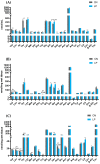Transcriptome and Methylome Profiling in Rat Skeletal Muscle: Impact of Post-Weaning Protein Restriction
- PMID: 36555412
- PMCID: PMC9779051
- DOI: 10.3390/ijms232415771
Transcriptome and Methylome Profiling in Rat Skeletal Muscle: Impact of Post-Weaning Protein Restriction
Abstract
Skeletal muscle is programmable, and early-life nutritional stimuli may form epigenetic memory in the skeletal muscle, thus impacting adult muscle function, aging, and longevity. In the present study, we designed a one-month protein restriction model using post-weaning rats, followed by a two-month rebound feeding, to investigate how early-life protein restriction affects overall body growth and muscle development and whether these influences could be corrected by rebound feeding. We observed comprehensive alterations immediately after protein restriction, including retarded growth, altered biochemical indices, and disturbed hormone secretion. Transcriptome profiling of the gastrocnemius muscle followed by gene ontology analyses revealed that "myogenic differentiation functions" were upregulated, while "protein catabolism" was downregulated as a compensatory mechanism, with enhanced endoplasmic reticulum stress and undesired apoptosis. Furthermore, methylome profiling of the gastrocnemius muscle showed that protein restriction altered the methylation of apoptotic and hormone secretion-related genes. Although most of the alterations were reversed after rebound feeding, 17 genes, most of which play roles during muscle development, remained altered at the transcriptional level. In summary, early-life protein restriction may undermine muscle function in the long term and affect skeletal muscle development at the both transcriptional and methylation levels, which may hazard future muscle health.
Keywords: methylome; post-weaning; protein restriction; skeletal muscle; transcriptome.
Conflict of interest statement
The authors declare no conflict of interest.
Figures




References
MeSH terms
Substances
LinkOut - more resources
Full Text Sources
Molecular Biology Databases

